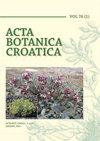Ecophysiological study of some coastal dune species of Zemmouri El Bahri (Algeria)
IF 0.7
4区 生物学
Q3 PLANT SCIENCES
引用次数: 0
Abstract
Species of coastal dunes are subjected to several environmental stress factors such as drought, high temperature, light intensity as well as salinity, which led to development of specific morphological, physiological and biochemical adaptation mechanisms. Studying these strategies allows explaining the survival of these species in such hostile and stressful conditions. In this study we compared some parameters (morphological, physiological and biochemical) of two Brassicaceae species Matthiola tricuspidata (L.) W.T.Aiton, Cakile maritima Scop., and two Fabaceae species Lotus creticus L. and Ononis variegata L., harvested from their natural environment in coastal dunes of Zemmouri El Bahri (Algeria), with the aim to understand their mechanisms of adaptation. The results revealed that C. maritime showed the highest relative water content, leaf area, leaf mass area, and succulence index. Based on the highest levels of total phenols, flavonoids and anthocyanins as well as high contents of photosynthetic pigments, M. tricuspidata can be classified as "homoiochlorophyllous" plant. The dry mass content varied considerably among species, with the highest values observed in L. creticus and the lowest in C. maritima. As both Fabaceae species L. creticus and O. variegata showed high chlorophylls, carotenoids, total phenols and flavonoids could also be classified as "homoiochlorophyllous" species. The relatively high levels of total phenols, total flavonoids, anthocyanins and carotenoids implies a biochemical adaptation that allows these plants to maintain necessary photosynthetic activity under a water deficiency condition.阿尔及利亚Zemmouri El Bahri部分海岸沙丘物种的生态生理研究
海岸带沙丘物种受到干旱、高温、强光、盐度等多种环境胁迫因素的影响,形成了独特的形态、生理和生化适应机制。研究这些策略可以解释这些物种在如此恶劣和紧张的条件下的生存。本研究比较了两种芸苔科植物Matthiola tricuspidata (L.)的形态学、生理生化指标。W.T.Aiton, Cakile maritime Scop。和两种豆科植物莲花(lotuscreticus L.)和Ononis variegata L. (Ononis variegata L.),采自阿尔及利亚Zemmouri El Bahri海岸沙丘的自然环境,目的是了解它们的适应机制。结果表明,海棠花的相对含水量、叶面积、叶质量面积和多肉指数最高。根据其总酚、总黄酮和花青素含量最高以及光合色素含量高的特点,可将其归类为“同质叶绿素”植物。干物质含量在不同种间差异较大,以白草最高,海草最低。由于豆科植物L. creticus和O. variegata均含有较高的叶绿素,类胡萝卜素、总酚和黄酮类物质也可归类为“同质叶绿素”物种。相对较高水平的总酚、总黄酮、花青素和类胡萝卜素意味着一种生化适应,使这些植物在缺水条件下保持必要的光合活性。
本文章由计算机程序翻译,如有差异,请以英文原文为准。
求助全文
约1分钟内获得全文
求助全文
来源期刊

Acta Botanica Croatica
PLANT SCIENCES-
CiteScore
2.50
自引率
0.00%
发文量
34
审稿时长
>12 weeks
期刊介绍:
The interest of the journal is field (terrestrial and aquatic) and experimental botany (including microorganisms, plant viruses, bacteria, unicellular algae), from subcellular level to ecosystems. The attention of the Journal is aimed to the research of karstic areas of the southern Europe, karstic waters and the Adriatic Sea (Mediterranean).
 求助内容:
求助内容: 应助结果提醒方式:
应助结果提醒方式:


